As a partner at Draper Fisher Jurvetson, Josh Stein has invested in some of the most well-known SaaS companies in the world like Box and Yammer and spent plenty of time with truly remarkable SaaS CEOs. In this session he and Jason Lemkin sit down and dive into what really makes a great CEO, and how that differs one that’s just “good”.
Josh shares insights into both the external challenges, like promoting a vision that goes beyond the company, to the internal challenges like a finding ways to stop doing everything yourself. When planning growth from $5m ARR to $10m ARR, great CEOs are simultaneously laying the groundwork for reaching $20m, where the good ones will fall “short” at only $12m or $14m. Most importantly, if you’re doubting your ability as a CEO, don’t internalize it. No one is born a CEO. Reach out to folks you respect and trust who’ve been there.
Check out the full transcript below!
If you want to see more sessions from 2016, we’re releasing a new one each week. Subscribe here to be notified. And be sure to grab your tickets to the 2017 Annual NOW.
TRANSCRIPT
Jason Lemkin: All right. Good morning, everybody.
Thanks for coming back. How was the party? Was it good? Let’s have a show of hands? Was it fun? I thought it was pretty cool.
As you can see, we changed up the stage again. The theme today is zen learnings. It’s the journey that we’re on. Tuesday, in theory, was about scaling. Yesterday was clearly about unicorns and money, to a large extent. Today’s about the journey. It’s a journey, right?
We’ve talked a lot on SaaStr and other places, that it’s 7 to 10 years in SaaS often to get to something real, and even longer. We’re going to explore that, in many cases with folks that have been on the journey for a while.
I want to start it up briefly, and I won’t read all of it, but I want to highlight a few things. My good friend, Josh Stein, from DFJ, who’s done some amazing early SaaS investments, will help talk about what makes a great SaaS CEO. I want to have a little bit of one on one because we have a hole there.
We’ll have amazing long term stories from Marketo and Cornerstone after that. I want to talk with Keith Rabois about building amazing teams. We’ll have a fun break. When Keith and I are done, stay here for five minutes for the Academy of Villains. Don’t leave.
We’ll have two sessions in the afternoon about that next five years, how to really scale, and how to take it to that next level. I think this is one of the most important topics.
One of the things I learned when I transitioned from founder to observer of founder, an angel and investor, and otherwise, is year five is where it gets tough. You get tired. The best CEOs and VPs in teams push through to that sixth year.
The other ones, it’s tough. You see a lot of transition in five years. You see a lot of folks handing the reins to other folks. I want to hear three great stories, which we’ll have, on that second five years.
We’ll end up with a fun session on founder and VP focused PR, what it really means. We’ll have an amazing session on a fun topic. “Should we even get PR? Why are people even here today on stage? How do you get it? What does it mean?” We’ll have a really fun wrap up, which I want you to stay after that.
Briefly, downstairs, it says it’s all about sales. We’ve had a lot of sales this week, but it’s really all about revenue. We added some fun things. In the morning, we’ll have another session like we did last year, but you get to see it live, of a great CEO and VP of sales together.
Someone from a B2D background that learned to love sales, and then watched not loving sales, and then learning to love it, and watch the impact of that, of going from nothing to millions and millions of revenue in one year, which will be fun.
We’ll talk about something that’s au courant, which is account based sales development, how to really target big guys. We all need to learn this. These two sessions I added because we were a little bit light on marketing. We’ll add more next year. These are amazing.
We’ll have Jeff Yoshimura, who’s gone from Salesforce to Zuora, to now, Elastic, on building an epic brand. I can’t think of anyone I’d want to learn more about corporate marketing and brand building than Jeff, this mysterious thing of building the brand.
Come hear Jeff. The dude’s awesome. A lot of us know him that have been in the industry for a long time. Then Megan Eisenberg, who’s now at MongoDB, and was at DocuSign before that. I competed with them and watched what she did from a distance. In terms of demand generation and lead generation, she’s bad arse. Go see the session. It’s going to be crazy.
We’ll have a few more sessions, selling to the enterprise, a real session, and two sessions on customer success, which as we know, in some ways, once you have something, nothing matters but customer success. It’s getting that net negative churn in, and building on the customer.
The downstairs stuff, the tactical theater was an experiment. It’s performed much better than we expected, so go see that stuff. It’ll be awesome. Some fun things that the team added, I’m not that fun, I’m intense, but we added some fun things.
At 11 AM, we’ll have a pretty cool surprise mystery guest. You may be able to guess who it is. We’ll make this session super fun, on the Box PlayBook. We’ll have the Academy of Villains, which I know nothing about, but should be super fun.
In the afternoon, I’m sure none of you are tired, but I might be a little bit tired, so in addition to the bars opening at 8:00, we’ll actually serve beer in the stands here, like at a ballgame, to make the afternoon more fun.
I want to bring Josh out in just a second, but I do want to acknowledge one thing. This whole event is about founders to founders, founders to VPs, and folks on the journey. That’s what we’re about.
We did lose one speaker from the agenda today, which I’m bummed about. I don’t want to go into too much detail, but I want to say I have the utmost respect for any founder that’s killed it, that’s done better than me, that’s blown it out of the water in a couple of years, and also that treats people incredibly well, that has high ethics and morals. That’s who we lost today. I’m bummed.
Man, this is hard, and it’s not perfect, but to have accomplished any of this stuff, this is the fellowship of the founders here. I have the utmost respect for the one speaker we lost, who was one of the first to commit, and would have done anything to be here.
With that, let me bring out Josh Stein, and let’s talk a little bit about great CEOs.
Josh Stein: Hey, man, thanks for having me.
Jason: Thanks for coming.
Josh: Yeah. Absolutely.
Jason: Josh is fairly stylish, so I DM’d him and said, “Let’s match the velour.” He said, “I’m totally into that.”
Josh: I’m totally into that.
Jason: That’s pretty good. Let me bring this up. A couple things on Josh. He’s done a ton of amazing SaaS and enterprise investments. He invested in Box at a, I think, early TechCrunch party, right? First institutional investor after Mark Cuban.
Josh: Yeah. First institutional investor. We met him at Mike Arrington’s house.
Jason: Mike. I remember those days, at Mike Arrington’s house. You know how to take a little bit of risk, right?
Josh: Yeah.
Jason: You’ve done other great ones, like Twilio and other amazing companies. We’ll talk a little bit about, but a few other things. I think it was E&Y, you were the VC of the year, right?
Josh: Deloitte.
Jason: Deloitte, sorry.
Josh: Yeah, E&Y’s no good. You’ve got to stick to Deloitte.
Jason: Sorry to my Deloitte friends in the audience.
Josh: The Deloitte guys know what they’re doing.
Jason: Deloitte, so cheers to that.
Josh: Thank you.
Jason: For the VC of the year, right?
Josh: I love you, man. Appreciate that.
Jason: A lot of sake and free beer, so that’s great.
There’s been a tiny bit of turbulence in the market, but you closed your new fund recently, right?
Josh: Yeah, we announced it on Tuesday, 350 million bucks.
Jason: No matter what anyone else, Goldman Sachs, or the markets say, life is good, right?
Josh: Yeah. I think that’s right.
I’m a believer. I think the long term trends in SaaS are super solid. The market’s going to move up and down. It’s going to affect things, but stick with it. I don’t see anything changing fundamentally.
Jason: Yeah. A couple of things I want to talk about on this theme of great CEOs, because when you and I met, when I was a founder, I didn’t know what a great CEO was. But then I got to watch some of my cohorts. I got to watch Peter Gassner, from Veeva. I met him, and I’m like, “I don’t know what this Veeva thing is, but this dude’s bad ass.”
I met David Sacks, who you invested in, and I’m like, “This guy’s pretty good. I met Aaron Levie, probably before you did, and I was like, “I know this cloud content thing’s supported, but there’s something in this guy,” but I didn’t know what it meant until I got a chance to do some angel institutional investing and see it.
What’s the difference between great and good? What do you see in Jeff, at Twilio, or Aaron? Just to help people calibrate, because it’s so hard to see early from the outside, what’s great? What makes them great?
Josh: I think the greatness often becomes apparent later. You were talking about those guys when they were running big companies, so it’s sort of like….
Jason: How do you go all the way back in time and see it early when you invest capital?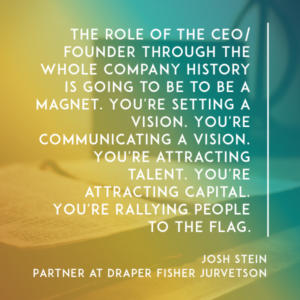
Josh: The role of the CEO/founder through the whole company history is going to be to be a magnet. You’re setting a vision. You’re communicating a vision. You’re attracting talent. You’re attracting capital. You’re rallying people to the flag.
It’s like this pulling together initially, and then as the company scales it’s like this North Star that pulls everything back together when things start to fray.
I think what’s really interesting from our perspective because we tend to invest mostly Series A, Series B, and what you’d now call C. When I invested in Box, it was three people in a garage, literally.
We’re getting involved with these guys super, super early. I think that sometimes people who are great early can scale all the way through, and sometimes they can’t. I think it’s because the role typically changes over time.
When I was a student at Stanford, Tom Seabolt, who I don’t know if people remember Seabolt anymore, was the fastest growing company in history at the time. He came in and he told us, “You know, when I was here I thought accounting and finance were the only things that mattered, and all the touchy, feely psychology stuff was just bullshit. I’m here to tell you, I had it completely backwards.”
He’s like, “I have people that do the accounting and the finance for me now. I spend all my time dealing with people issues.”
I think that’s probably the hardest single thing is for founders who are often technical, who are often young, realizing that if you have a thousand people, a big part of your job is making sure you’ve got the right leaders in the right chairs, and making sure that you’ve got strong processes.
All those thousand people have hopes, and dreams, and career aspirations, and how you manage that. The leadership part is relatively constant throughout, communicating the vision, but the people stuff really tends to trip people up.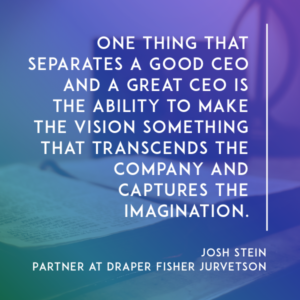
I think that’s one thing. The other thing I think with a great CEO versus a good CEO is on the vision part, being able to make the vision something that transcends the company and captures the imagination.
This isn’t a SaaS example, but I think Elon Musk is, for example, the best at this. SpaceX isn’t about launching satellites into space. It’s about going to Mars. Tesla’s trying to save the world by killing the car.
Aaron, if I look at Aaron, I think that’s one of his great gifts, is I think that Aaron is incredibly compelling at painting a vision of Box, beyond boxes and storing files, Box is reinventing collaboration and changing how business is going to be done. Right?
Jason: Yeah.
Josh: That’s the part I don’t think you can necessarily teach. I actually think the other stuff can be learned.
Jason: Fair enough. Let’s have a little fun with Aaron. You invested in Aaron when he was 21, or something like that probably?
Josh: Yeah.
Jason: 22.
Josh: 21, I think.
Jason: That’s mid pack today for a lot of SaaS founders, but back in the day that was considered young, right?
Josh: Yeah.
Jason: You’ve had a chance to observe him over 10 years, how did he scale? What were the things that he did to be able to…How many Box employees do we have today?
Josh: A little under 1,400.
Jason: 1,400, right?
Josh: Yeah.
Jason: So he scaled, right?
Josh: Yep.
Jason: He scaled. He’s one of the most articulate, poised…
Josh: Yep.
Jason: He’s almost an elder statesman of SaaS for many of us today, right?
Josh: He really is.
Jason: At 30.
Josh: Which is great. I think he’s 31 or 32.
Jason: How did he address some of those challenges, and how was he able to scale as a CEO?
Josh: It’s funny, you were saying when we first met Aaron, I sometimes tell people, I feel like I really met Aaron for the first time about a year and a half or two years into our investment, when I first started working there.
Box was actually more of the consumer idea when we originally backed it. He was your classic consumer founder. He was wearing t-shirts and shorts, and he’d have hair rumpled and the whole thing. That kind of works when you’re dealing with credit card signups and $10 stuff.
Then we stumbled on this idea of, “Wow, maybe the bigger opportunity here might be for businesses.” It was this realization that the best customers, the ones who were paying us the most that churned the least, that actually were interestingly consuming the least resources from a cost of goods standpoint were the businesses.
I’ve never seen anyone make such a complete 180. He spent about a week, went from, “We’re a consumer company to an enterprise company,” and he burned the boats. He said, “We’re going full enterprise, total commitment,” and then I think he realized that to be successful in that, he would have to transform himself into this enterprise leader.
This is when I knew, when I say, “I think it can be learned,” there are resources out there, there’s books, there’s all the stuff that Jason has done on SaaStr, which we didn’t have back then, just an incredible corpus of information. There’s people that you can learn from.
I think a lot of it is just force of will. Aaron basically worked 24 hours a day, read every book he could get his hands on, tried to network and mentor with every enterprise leader he could find and if you look at him today, he is a legitimate thought leader in the space.
He walks with CIOs that are controlling $5 billion budgets, and they look at him as somebody that they’re looking to for guidance about their strategy, and that is just pure force of will. He didn’t pop out of the womb knowing about the enterprise transformation. I think having both the discipline, the desire, and the lack of ego to say, “I’m going to go learn this stuff,” is incredible.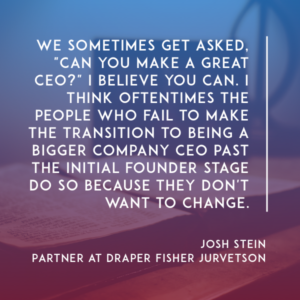
I think just the amount of written material that’s available out there is staggering. I think one of the questions we sometimes get asked is, “Hey, can you make a great CEO?” I believe you can. I think the people who often fail, not always, but often fail, to make the transition to being a bigger company CEO, past that initial founder stage, is they don’t want to change.
They say, “This is me,” like, “I’m not a good public speaker. I don’t want to sit down and give people one on one reviews.” That’s a choice that you’re making. You’re saying that you’re not good at that. You’re saying that you don’t want to do it, but you have to recognize, that’s a choice.
I can sit down and teach anybody how to do a one on one review. It’s not that hard, but you’ve got to want to do it, and you’ve got to suck it up and say it. If you’re afraid of public speaking, get out there and do it. Practice makes perfect, but you need the commitment and you need the openness to change.
Jason: Let’s dig in a little bit on that. “I’m here. I’m a driven founder. I’m in a million in revenue, or whatever, and I don’t want to get burned out at year five. I want to go the distance, right? I’m hardcore. I see all of this.”
Those are some good anecdotes, but what are the best couple of things I might be able to do today to ensure that I don’t burn out, and I at least have a shot at being the next Jeff Lawson or Aaron Levie. What can I do?
Josh: Jeff, I think, is a great example of this, actually, somebody who’s maintained that incredible growth, incredible scaling, and maintained this constant thing. I think one thing that helps a lot is to realize that it’s not about being the hero leader, where, “I’m going to do it all myself.”
If you look at a leader like Marc Benioff today, he’s mostly external. His job is really dealing with 7, 8, 10 senior leaders, all of whom could run large public companies themselves, so they’re in a sense almost like peers to him, and making sure that they have clearly defined roles and responsibilities and the resources they need.
What Jeff has done at Twilio that I think is so remarkable is he’s hired an incredible team around him, and he’s built an incredible culture and set of values. Twilio has this really neat…
You can check it out at the Twilio website. It’s these Nine Values of Twilio, and they’re these very clarifying principles, that, “This is what Twilio stands for. This is what we’re going to do. This is what we’re not going to do.”
It makes everything so much easier, because a lot of the stress in the CEO role comes when you have two executives or two people who are really both trying to solve the problem, but they have this conflict?
Jason: Yeah, it’s a tough one.
Josh: If you have clarifying culture and vision, it sometimes helps to resolve that. One of the Twilio values I really love is “No shenanigans.” There’s a lot of nonsense and shenanigans in enterprise pricing.
It’s like hidden upcharges. Jeff’s favorite bugaboo is the “Call us for the enterprise version.” It’s like 100 bucks a month, 1,000 bucks a month. “Call us,” which is basically code for, “We’re going to see how much we can get out of you.”
Twilio is just transparent, simple pricing, and we have had talks, like, “Hey, are we leaving money on the table?”, and he’s like, “Nope, no shenanigans.” Boom. That makes it a very short conversation.
Jason: It at least makes the alignment very simple, right?
Josh: Yeah, and it saves him a lot of stress. He’s built a tremendous team around him, so it’s like as the company gets bigger, you should be moving up in the organization. You should be less involved with the day to-day work, more involved in the strategy, and usually getting pulled more external to the company, not internal. It’s not always, but that’s generally the thing.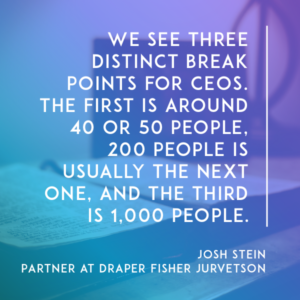
I always tell people, we see three distinct break points for CEOs. The first is around 40 or 50 people, and that’s usually where communications break down. You can’t just rely on osmosis to get information out in the company anymore. You’ve got to actually write things down and have meetings.
200 people is usually the next one. That’s where you start having span of control issues, where it’s not, “I have a report,” and then they have the report, and that’s the engineer, or that’s the salesperson, but there’s maybe two or three layers, and so…
Jason: Almost none of us have dealt with managers and managers before, right? It’s just on founders…
[crosstalk]
Josh: Managers and managers, exactly, and so understanding, and that’s you’ll start bringing in people who are executives, and executives start grabbing power and resources, and understanding how to deal with that.
1,000 is really interesting, because at 1,000, if you’re interacting, from a reporting relationship, with more than, I’d say, 6 to 10 people, you’re really probably doing something wrong.
You’re spending most of your time externally, and then most of your time, you probably have not met most of your employees in person, but you are known to them. You’re a beacon to them, and so you’re setting that vision, clarity, and purpose, but it’s really much more about being a figure as opposed to a person that’s interacting with them directly.
Jason: Let me ask one question, and sometimes people make mistakes on it. You’ve got to stop owning everything yourself early, right?
Josh: Yep.
Jason: That’s a mistake we all, most of us that can multitask, we own too much choice, so bring in the right management team. A lot of times we try to bring in someone early that can do it all as COO, sometimes, right?
Josh: Mm hmm.
Jason: It worked great at Box, right?
Josh: Yeah, it really did.
Jason: We talked with Aaron up here last year. When should I bring in, whether it’s literally a COO or a deep number two, and when is that a crutch and too early, and something that…I meet more and more founders that are a million in revenue. “What’s your next plan?” “I’m going to hire a COO,” and I get nervous when I hear that, right?
Josh: Yeah, I think they think it’s going to be a magic bullet. It’s like when a technical founder says, “I’m going to hire the VP of Sales, and they’re going to start selling stuff,” right?
Jason: A magic bullet. Yes, this is the VP of Sales 2.0, is, “My COO is going to handle all the operational stuff at a million in revenue.”
Josh: Ben Horowitz wrote a great post on this, on the dangers that…I forget what he called it. It was like “shared…” Anyway, look up the Ben Horowitz post. He talks about why Workday works and other ones don’t.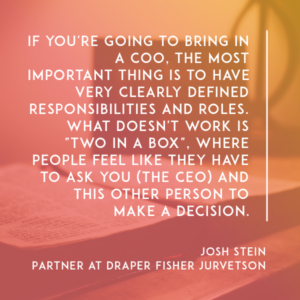
I think the most important thing, if you’re going to bring in a COO, is having very clearly defined responsibilities and roles. What does not work is two in a box, where people feel like they have to ask you and this other person to decide, and if you can’t find both, or they disagree what happens, everyone gets really confused. Their people have to be clearly defined.
For example, at Box, Dan basically had the vast majority of the entire go to market function rolling up in to him, and Aaron has product, and has the CFO, and has the entire external vision part of the company. They have a trust relationship that’s very clear.
If you’re going to have a COO, you have to say, “I’m not going to overrule you, even if I disagree with you,” so you are empowered to make decisions, people know you’re empowered to make decisions.
“We’re going to have our one-on-ones to make sure we’re aligned.” You’ve got to watch out for the two in the box thing. I’d say a million in ARR’s too early. I think 40, 50 people is probably where it might become relevant, something like that.
Jason: I’d love to do a half an hour on this, but let me do one last question on this whole thing, because another thing, I hear a lot the COO too early. The other one that I don’t like to hear as a founder, is when I meet a founder, and they’re not sure if they’re the right guy at 20 million or 30 million, right?
Josh: Yep.
Jason: As the VC of the year, you have to think about these issues when you make an institutional investment. The question I have to you is if you’re a founder here, and you’re doing well, but I’m not sure I can go the distance, what’s your advice to me? How should I be self critical?
I’m confident, I’m at 1.3 million ARR. I’m growing at 11 percent a month. I don’t even have any venture backing.” That’s hard to do in the grand scheme of things. What’s the advice if I don’t know?
Josh: Two things. I would encourage people to not internalize the question. It’s not, “Are you capable, or are you good enough to do it?” I think most people with sufficient commitment can make it happen. The question is, “Do you want to it? Are you willing to make the commitment to do it?” Think of it as you basically have to go to school on the side to learn how to do that job.
Jason: The Aaron school story’s a great one.
Josh: Yeah. You can learn everything that Jason’s written on Quora. You want to read every business book that you can find. You’re going to have to really commit to developing that. Some people might say, “I just don’t want to do that,” and then you know, then you know the answer.
Jason: If you don’t want to do it, you know.
Josh: If you don’t want to do it, it’s you. That’s the answer. I think that’s really the key thing, is do you want to make it happen or not?
I think self awareness is good. It’s so hard as a founder and CEO. You bear all these burdens and the doubt, and it can eat away at you, and you can’t always share it. That’s what I always tell people.
Jason: It’s hard.
Josh: That can be a role of a venture board member. The companies I work with, I only win if they win, I lose if they lose. I’m completely aligned with the founders, so have that conversation openly.
We’re not going to judge you. we’re not going to say, “You know, she’s feeling inadequate, therefore must be time to go.” We’re going to say, “Hey, let’s figure out how we either fix this together, or if not, let’s move on.
One things companies always forget is, let’s say you’re going from 5 to 10 million in revenue. It’s not just going from 5 to 10, it’s going from 5 to 10, and in that year, you’re laying the groundwork to go from 10 to 20. If you’re not, you’re going to go from 10 to 12, or 10 to 14.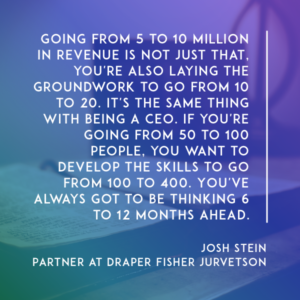
It’s the same thing with being a CEO. If you’re going from 50 to 100 people, you want to to be developing the skills to go from 100 to 400. It’s like you’ve always got to be thinking 6 to 12 months ahead in terms of those skills you’re building.
Jason: I think that’s right. I think that’s great advice. When any of us, every once in a while, have these doubts as founders, don’t internalize it too much. Get external feedback on this. When I went through it, I asked a lot of my peers and mentors, and everyone said, “Go for it man. You have something good, just keep going for it.”
Josh: Nobody’s born a CEO.
Jason: What’s that? Nobody’s born a CEO.
Josh: Nobody’s born as an executive. Everyone learned it, so the question…if you got to a million in ARR, you’re clearly smart enough that you can learn this if you want.
Jason: That’s a good way to end it. Thanks Josh, this was amazing. I really appreciate it. It’s a good way to kick it off.
Josh: All right.
